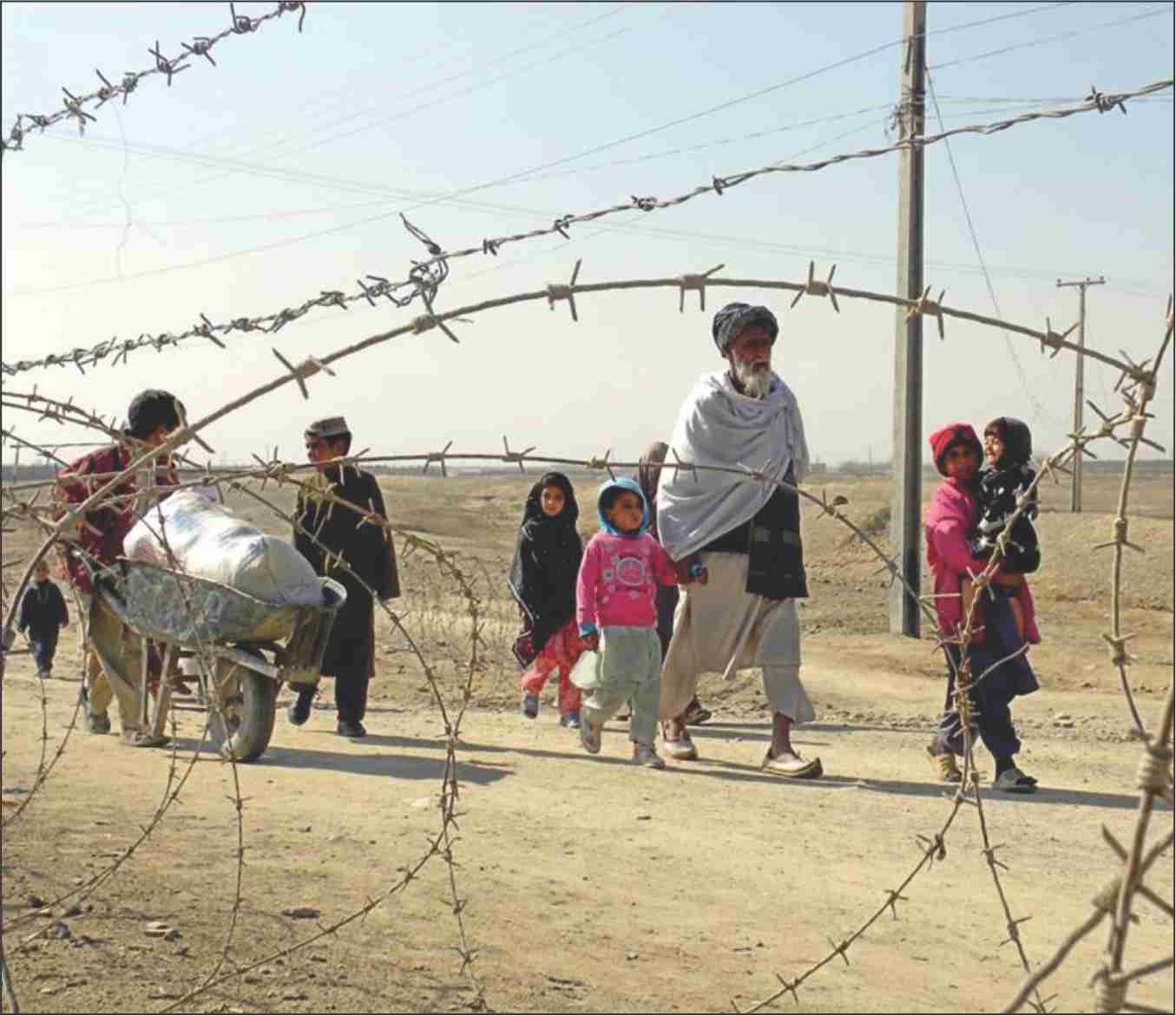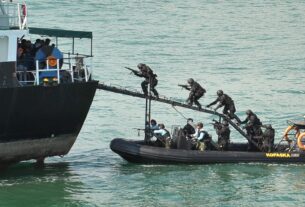Pakistan-Afghanistan border conflict
The violent clash between border forces of Afghanistan and Pakistan at Torkham crossing may appear to have ended, but it reflects a deep rooted disconnect between these two South Asian neighbors.
Though the clashes in Torkham were triggered by the construction of a border post by Pakistan on its side, the border tensions are a symptom of a larger bilateral problem which if not tackled timely may have big and irreparable consequences.
Tensions have been brewing for a while over Pakistan’s attempts to erect a gate on the border. Afghanistan has long opposed this idea as it does not recognise the gate as a legitimate dividing line.
Pakistan’s moves towards fencing a 2km area at the Torkham crossing, was opposed and stopped by Afghanistan.
The row led to Pakistan’s closure of the crossing, affecting thousands of people who commute across the border each day.
Any construction near Torkham is a violation of bilateral agreements between Afghanistan and Pakistan. The build up to this conflict started when Pakistan stopped allowing movement of people without visas from crossing Torkham to the Pakistani side of the Durand Line, not recognised as the international border by Afghanistan.
Pakistan shares a 2,500 kilometre-long borderline with Afghanistan. Over 15,000 people are said to illegally move across the Torkham crossing post located on the Durand line border, on a daily basis.
Since the December 2014 terrorist attack on Peshawar’s Army Public School, Pakistani authorities, who claim that the militants entered Pakistan through Torkham, have sought to further regulate the movement of people and goods through the border.
In April this year Pakistan issued notification asking all Afghan nationals residing in Torkham to vacate the area.
Over 300 Afghan families were evicted from the border town the following week. Tensions mounted as Pakistani authorities demolished houses of Afghan nationals in Torkham.
Pakistan’s interest
Pakistan says there is an infiltration of fighters from the Afghani side, and fencing of the border was the only immediate solution to keep a check on the people crossing.
Besides, Pakistan also claims that it would like to restrict the movement of people across the border and make it legal. Pakistan has been hosting Afghan refugees in millions.
Pakistan wants to control the movement across its borders. It has also been accusing Kabul of not doing enough to prevent the Tehrik-e-Taliban Pakistan (TTP) from using Afghan territory as a safe haven. Its spokespersons have repeatedly emphasised that militants use the unregulated Torkham crossing to enter into and escape from Pakistan.
However, Kabul has accused Pakistan of harbouring fighters seeking to topple the Afghan government, including the Haqqani network, blamed for high-profile attacks in the capital.
Since Afghanistan contests the entire border, Pakistan’s claim of constructing a post within its “own border” is objectionable for Kabul. The Afghans fear that Pakistan is attempting to convert the Durand Line into a “de facto border”.
In past couple of years, Afghan leadership has leveled allegations regarding terrorists, making their way to Afghanistan through Pakistan. Doubts have been also raised on the double standard and duplicity adopted by Pakistan under the garb of managing borders.
It is said that Pakistan is only trying to manage borders along Afghan border where its interest lies, however it overlooks the region like FATA and NWFP which has become the hub of illegal traders, infiltrators and terrorists.
Therefore, Torkham is not just a border problem , it is a big political and security issue which needs to be tactfully tackled.
Pashtun issue
Viewed from the perspective of Pakistan’s desire to bring an end to the Tehrik-e-Taliban Pakistan led insurgency and address concerns over the large number of undocumented Afghan refugees in Pakistan, Islamabad’s desire to secure its borders and regulate the flow of people and goods from Afghanistan appears to be entirely legitimate.
However, the reality of the challenge Pakistan faces is that much of the 1,500-mile border between Pakistan and Afghanistan is unregulated. The two countries have a handful of checkpoints, of which Torkham and Chaman to the south are the largest, but vast swathes of unmanned territory allow refugees, smugglers and militants alike to cross over into Pakistan without detection. Strengthening security at Torkham, therefore, while commendable, will not likely alleviate Pakistan’s immediate challenges along the border.
There are more than 40 points on the Pak-Afghan border that have been exceeded by Pakistan or Afghanistan. However, security issues remain a determinant factor in resolving the problem. Pakistan has 535 border posts on the Durand Line against just 145 of Afghanistan. By this ratio there is one Pakistani border post at every two kilometres and an Afghan post at every 7.8 kilometres.
Pakistan has launched its first modern border management system on the Torkham border post. But the remaining seven borders, located all the way up to Chitral and Waziristan, will not witness similar upgradation in the near future as the country claims it has lack of funds and priority. Thus, smugglers, terrorists or refugees can freely cross into either side of the frontier.
Torkham (along with Chaman across Balochistan) is no regular border crossing. Historically and culturally, Pashtuns living on both sides have been crossing the Durand Line. Many Pashtuns living along the western side of the Durand Line move across (into the Federally Administered Tribal Areas) for social and economic reasons every day with no concerns about legal documents or political sovereignty.
While Chaman and Torkham are major crossing points, there are numerous other points from Bajaur to South Waziristan. The Afghans see this as a “social” border, hence object to any legal sanctification until the border is politically approved by both countries.
The Pakistani government was claiming that it took the step of managing Torkham border to crack down on terrorism but Pashtuns insist that curbs are placed on the travel of common people and travel of terrorists is facilitated by Pakistan. Pashtuns live on either side of the Durand Line and have parts of their families living on both sides.
This has made even Pakistani Pashtuns unhappy over the country’s decision to build gates at the Afghan border. If such incidents increase in future, there could be a possibility of Pashtuns uprising in the area, after the similar brewing revolts of Balochistan and GilgitBaltistan.
Afghanistan is also apprehensive that making the border point in Torkham completely legal and document-based will affect the larger movement of Pashtuns across the Durand Line difficult and selective.
Besides, though there is smuggling across all South Asian borders, Torkham, Chaman and Taftan are the main hotspots. Further, corrupt practices along the Pakistan-Afghan and Pakistan-Iran borders further complicates regulation. So it appears that when Pakistan talks about strong border management, it primarily focusses on controlling the legal movement of people and goods, while letting the illegal movement go unhindered or strictly controlled.
As a land-locked and impoverished country, Afghanistan is heavily dependent upon Pakistan both as an export market and as a transit point to other destinations. Indeed, Pakistan remains Afghanistan’s largest trading partner and serves as a vital transit point for trade to and from Afghanistan. For Washington and its allies, the road through the Khyber Pass via Torkham served as the main supply line into Afghanistan.
Pakistan has often used this leverage as a tool for negotiation and coercion. Indeed, Pakistan has closed Torkham on multiple occasions in the past when issues have flared up between Pakistan and Afghanistan.
Pakistan, Afghanistan and Iran need to work towards a cooperative framework of border management and identity sharing to check the regular and irregular movement of individuals and goods. While curbing terrorist and drug cartel requires effective intelligence and operational measures, realistic trade rules and regulations can help stem the smuggling of goods.
Effective border management is a challenge for Pakistan as it requires greater resources, manpower and above all the mutual consensus over terms of both neighboring countries.
In the light of regional dynamics, Pakistan and Afghanistan have to align their interests. It must be understood that matters between Pakistan and Afghanistan can only be sorted through diplomatic means, use of force or violence is no option. It is through action against terrorists and effective border management that both countries can counter terrorism.
The border issue needs to be carefully resolved as it is not just a matter of ensuring security, it has both social and political dimensions which needs to be handled tactfully to avoid future violent clashes.




